COMMENT OF THE DAY: HOLDING BACK THE ONSLAUGHT ON A GALLERIA MOD 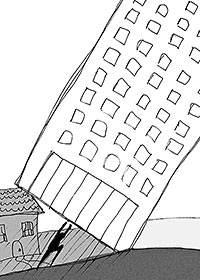 “There’s not too much respect for older architecture in Houston. I own a three family near the Galleria. My building was designed by Neuhaus and Taylor and was featured in ‘Houston and the Mod House.’ The developers are sniffing around trying to make deals for the whole street. I may reach a point of diminishing returns soon and be forced to sell. One of the reasons is that the city keeps raising the property taxes so high in ‘hot’ areas by comparing old buildings to the new ratables and raising the old assessments by thousands at a time. At some point you can’t afford to pay the bills with a density of three units on the property. A developer will come in, buy the whole cul de sac, and put up a tower so he can make a lot more money per sq. ft. from the land than we can. When you protest taxes, HCAD listens and lowers the amount a tiny amount. Thus, the little guy is eventually forced out.” [Gary Andreasen, commenting on Comment of the Day: How Houston Tears Down and Sprawls] Illustration: Lulu
“There’s not too much respect for older architecture in Houston. I own a three family near the Galleria. My building was designed by Neuhaus and Taylor and was featured in ‘Houston and the Mod House.’ The developers are sniffing around trying to make deals for the whole street. I may reach a point of diminishing returns soon and be forced to sell. One of the reasons is that the city keeps raising the property taxes so high in ‘hot’ areas by comparing old buildings to the new ratables and raising the old assessments by thousands at a time. At some point you can’t afford to pay the bills with a density of three units on the property. A developer will come in, buy the whole cul de sac, and put up a tower so he can make a lot more money per sq. ft. from the land than we can. When you protest taxes, HCAD listens and lowers the amount a tiny amount. Thus, the little guy is eventually forced out.” [Gary Andreasen, commenting on Comment of the Day: How Houston Tears Down and Sprawls] Illustration: Lulu
COMMENT OF THE DAY RUNNER-UP: WHAT THE HOME LISTING STATUS CODES REALLY MEAN  “For those of you that think you know about real estate, but don’t, you will find a breakdown of HAR statuses at the bottom of this post. Pending Continue to Show (PS) means that the seller is still willing to have the house shown. It does not mean that there are necessarily any contingencies, it just means that they *might* still allow showings. They still have the right to decline a showing when an agent tries to schedule an appointment, and many sellers do choose to decline the showing, or at least don’t tend to be as flexible as they may have been before the home was under contract. The reality is that most agents don’t show homes that have a PS status anyway, unless the listing agent makes it a point to specify that the seller is willing to accept back-up offers. Many agents don’t use Pending (P) unless the seller absolutely insists on no further showings.
OP — Option Pending: Listings that are under contract and the seller and buyer have agreed to use the ‘Termination Option’ in paragraph 23 of the standard TREC contract, effective 1/1/03;
PS — Pending Continue to Show: Used for listings currently under contract but are still available to show. Listings having a contract with a contingency and taking back-up offers should be Pending Continue to Show;
P — Pending: Used for listings under contact and are no longer available to show;
S — Sold: Used when a property has funded and closed. All sales closed must be reported to MLS. Listings should not be changed to Sold status before the actual closing.” [HoustonRealtor, commenting on Restocking a Converted Grocery Store in the Houston Heights] Illustration: Lulu
“For those of you that think you know about real estate, but don’t, you will find a breakdown of HAR statuses at the bottom of this post. Pending Continue to Show (PS) means that the seller is still willing to have the house shown. It does not mean that there are necessarily any contingencies, it just means that they *might* still allow showings. They still have the right to decline a showing when an agent tries to schedule an appointment, and many sellers do choose to decline the showing, or at least don’t tend to be as flexible as they may have been before the home was under contract. The reality is that most agents don’t show homes that have a PS status anyway, unless the listing agent makes it a point to specify that the seller is willing to accept back-up offers. Many agents don’t use Pending (P) unless the seller absolutely insists on no further showings.
OP — Option Pending: Listings that are under contract and the seller and buyer have agreed to use the ‘Termination Option’ in paragraph 23 of the standard TREC contract, effective 1/1/03;
PS — Pending Continue to Show: Used for listings currently under contract but are still available to show. Listings having a contract with a contingency and taking back-up offers should be Pending Continue to Show;
P — Pending: Used for listings under contact and are no longer available to show;
S — Sold: Used when a property has funded and closed. All sales closed must be reported to MLS. Listings should not be changed to Sold status before the actual closing.” [HoustonRealtor, commenting on Restocking a Converted Grocery Store in the Houston Heights] Illustration: Lulu
FARRAGO FORCED TO LEAVE COSTLY MIDTOWN GROUND FLOOR 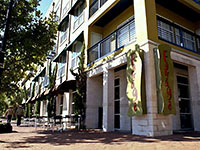 After 13 years of serving mimosas in Midtown, Farrago World Cuisine is closing. Catty-corner from the under-construction Midtown Park and one of the first ground-floor participants in that two-block urban walkability experiment around the Post Properties buildings at Gray, Webster, and Bagby, Farrago announced the shuttering in a recent Facebook post that suggests how primo the ‘hood is becoming: “We endured the construction, paid parking and towed customers. Alas, the over double rent was more than we could bare.” [Facebook; previously on Swamplot] Photo: Farrago World Cuisine
After 13 years of serving mimosas in Midtown, Farrago World Cuisine is closing. Catty-corner from the under-construction Midtown Park and one of the first ground-floor participants in that two-block urban walkability experiment around the Post Properties buildings at Gray, Webster, and Bagby, Farrago announced the shuttering in a recent Facebook post that suggests how primo the ‘hood is becoming: “We endured the construction, paid parking and towed customers. Alas, the over double rent was more than we could bare.” [Facebook; previously on Swamplot] Photo: Farrago World Cuisine
WILL GREENWAY PLAZA SALE MEAN NEW GREENWAY PLAZA TOWERS?  The 10 buildings and 52 acres that make up Greenway Plaza have been sold by Crescent Real Estate to Atlanta firm Cousins Properties for $1.1 billion. (The 3-city deal also gives Cousins a 40-story office tower in Fort Worth.) For now, reports the Houston Chronicle, it doesn’t appear that the change in ownership will change the property — though Cousins doesn’t seem to have ruled anything out: “Though there are no immediate plans for development, the . . . complex could house an additional 2 million square feet worth of office buildings, [Cousins CEO Larry] Gellerstedt said. The future development sites are parking structures that could be replaced by new towers.” [Houston Chronicle ($); previously on Swamplot] Photo: Crescent Real Estate
The 10 buildings and 52 acres that make up Greenway Plaza have been sold by Crescent Real Estate to Atlanta firm Cousins Properties for $1.1 billion. (The 3-city deal also gives Cousins a 40-story office tower in Fort Worth.) For now, reports the Houston Chronicle, it doesn’t appear that the change in ownership will change the property — though Cousins doesn’t seem to have ruled anything out: “Though there are no immediate plans for development, the . . . complex could house an additional 2 million square feet worth of office buildings, [Cousins CEO Larry] Gellerstedt said. The future development sites are parking structures that could be replaced by new towers.” [Houston Chronicle ($); previously on Swamplot] Photo: Crescent Real Estate


Swamplot reader Robert Meaney sends some observations along with these photos from the Fifth Ward of the 136-acre former KBR industrial property, sold a little more than a year ago and most recently designated for use as a private helistop: “I know they have been excavating for some time to get the contaminated soil out of the area. Currently they are scheduled to be finished digging up the lot by [December of] this year and according [to] the KBR manager I talked to on site the land will be up to commercial and residential standards.”
- Previously on Swamplot: Helicopters Over Clinton?, New Mystery Owners of 136 Acres in the Fifth Ward, Along the Shores of Buffalo Bayou, The Clearings on Clinton
Photos: Robert Meaney
COMMENT OF THE DAY: HOW HOUSTON TEARS DOWN AND SPRAWLS  “. . . In other (mostly northern) cities properties are continuously rehabilitated and repurposed. In Houston, properties are abandoned and demolished and the city sprawls out further from the center. I think that is a fundamental flaw in the mindset (and before anyone starts screaming — I know since I have remodeled properties considered tear downs in the Heights that have proven to be great investments). Granted, it takes guts and money and it may not be worth it to buy something like this, but there are other properties worth saving all over the Heights, Montrose, river oaks, and 6th ward. Every time I see an abandoned property in those neighborhoods it makes my head spin.” [Heights Mom, commenting on Snooping Around an Abandoned Apartment Complex in Inwood Forest] Illustration: Lulu
“. . . In other (mostly northern) cities properties are continuously rehabilitated and repurposed. In Houston, properties are abandoned and demolished and the city sprawls out further from the center. I think that is a fundamental flaw in the mindset (and before anyone starts screaming — I know since I have remodeled properties considered tear downs in the Heights that have proven to be great investments). Granted, it takes guts and money and it may not be worth it to buy something like this, but there are other properties worth saving all over the Heights, Montrose, river oaks, and 6th ward. Every time I see an abandoned property in those neighborhoods it makes my head spin.” [Heights Mom, commenting on Snooping Around an Abandoned Apartment Complex in Inwood Forest] Illustration: Lulu
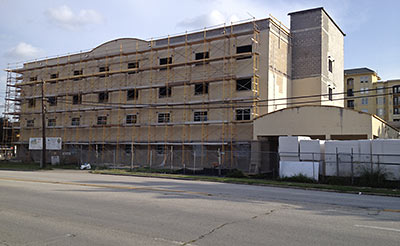
A new residence hall for men rehabbing from drug and alcohol addiction looks to be shaping up in Midtown. Designed by Roesler Architects, the 4-story, 26,000-sq.-ft. building will hold 64 efficiency units meant to house 2 men at a time; each unit, according Roesler, will have a microwave, refrigerator, built-in desk, and a coffee bar. There will also be what Roesler describes as a “Linear Courtyard” — a fenced-in landscaping feature, presumably — that will be accessible from the dayroom on the first floor. The new building is located at the corner of Alabama and San Jacinto, east of the Men’s Center headquarters across Main St. from the construction of Broadstone 3800, the 5-story apartment complex facing the light rail line on Main.


It’s taken a bit longer than Patrick Renner initially expected — he told Glasstire back in January that the “Funnel Tunnel” would be installed in February — but at least the sinuous steel frame that will be covered in repainted salvaged lumber was set up today in Hyde Park. You can see the giant tomato cage on Montrose Blvd., right in front of Inversion and the Art League of Houston.
- The Public in Public Art: Houston Community Helps Create “Funnel Tunnel†[Glasstire]
- Previously on Swamplot: Montrose: Where the Weird Things Are
Photos: Allyn West
COMMENT OF THE DAY: HOUSTON’S MASTER PLANNERS  “. . . I’ve talked a lot about the bad way some developers approach growth in Houston. But neighborhoods are addressing it wrong, too. They’re too reactionary. They sit around doing nothing until a developer proposes something they don’t like, then they mobilize to try to kill it. They need to ask themselves ‘what do we really want in and around our neighborhood,’ and then create master plans to communicate it. (The master plans wouldn’t be enforced — that would be zoning — but they could be used by developers to get a sense of what the neighbors would oppose.)
The Super Neighborhoods were supposed to be a venue where this could happen — they were originally under the auspices of the Houston Planning Department. But I’ve found that it’s actually the Management Districts that are doing master plans. It’s great that they’re happening, but Management Districts are paid for by and primarily serve businesses; and single family neighborhoods aren’t even trying to get in on the efforts.” [ZAW, commenting on Dogging the Morrison Heights Midrise with Doggerel] Illustration: Lulu
“. . . I’ve talked a lot about the bad way some developers approach growth in Houston. But neighborhoods are addressing it wrong, too. They’re too reactionary. They sit around doing nothing until a developer proposes something they don’t like, then they mobilize to try to kill it. They need to ask themselves ‘what do we really want in and around our neighborhood,’ and then create master plans to communicate it. (The master plans wouldn’t be enforced — that would be zoning — but they could be used by developers to get a sense of what the neighbors would oppose.)
The Super Neighborhoods were supposed to be a venue where this could happen — they were originally under the auspices of the Houston Planning Department. But I’ve found that it’s actually the Management Districts that are doing master plans. It’s great that they’re happening, but Management Districts are paid for by and primarily serve businesses; and single family neighborhoods aren’t even trying to get in on the efforts.” [ZAW, commenting on Dogging the Morrison Heights Midrise with Doggerel] Illustration: Lulu
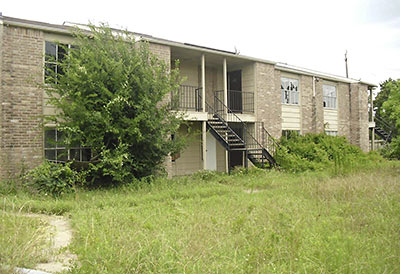
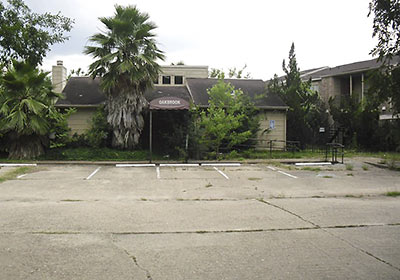
An intrepid Redditor recently explored the vacant Oakbrook Apartments and snuck away with these photos. The 222-unit complex, currently for sale, sits on 7.3 acres at 5353 De Soto St., east of Antoine and north of W. Tidwell, right up against White Oak Bayou. Writes the creative trespasser: “The majority of [the apartments] are unsecured at this point. There really didn’t seem to be much of anything left in any of the apartments, and I went in a lot of them. Most of the drywall is crumbling and you can smell the mildew from 20 yards away. Wiring and other appliances have been torn out in most of them.”
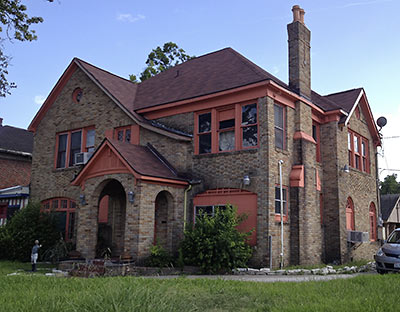
Yeah, this old one is a goner: A rep from the city says that a variance application to reduce the building setback has been approved for this corner in Museum Park, making just enough room on the 8,100-sq.-ft. lot at Jackson and Blodgett so 4 townhomes can squeeze on in. The peach-trimmed, converted-into-apartments building at 1702 Blodgett St., catty-corner from the art gallery that opened in the strip center, was in the Daily Demolition Report this morning. County records show that the doomed 4,220-sq.-ft. building dates to 1935.
SOME REAL-LIFE OCCUPANTS FOR GALVESTON’S LONG-ABANDONED BREWERY?  The endangered historic Falstaff Brewery that once harbored a bunch of scared architecture students in a horror flick might become a real refuge for Galvestonians looking for cheap housing — or so Culturemap’s Tyler Rudick seems to think, divining a hint about Dallas developer Matthews Southwest’s plans for the property from the very title of the rep he interviews: “Company officials are unable to reveal the full details until a purchase is finalized,” cautions Rudick. “But [we] spoke with current project leader Scott Galbraith, whose position as Matthews Southwest’s vice president of affordable income development suggests the company’s larger plans for the complex.” Perhaps, but Galbraith is also quick to point out that Matthews Southwest is keeping its options open while studying the site; previous environmental investigations have found plenty of asbestos in the 313,000-sq.-ft. building and soil contamination around it. [Culturemap; previously on Swamplot] Photo: Candace Garcia
The endangered historic Falstaff Brewery that once harbored a bunch of scared architecture students in a horror flick might become a real refuge for Galvestonians looking for cheap housing — or so Culturemap’s Tyler Rudick seems to think, divining a hint about Dallas developer Matthews Southwest’s plans for the property from the very title of the rep he interviews: “Company officials are unable to reveal the full details until a purchase is finalized,” cautions Rudick. “But [we] spoke with current project leader Scott Galbraith, whose position as Matthews Southwest’s vice president of affordable income development suggests the company’s larger plans for the complex.” Perhaps, but Galbraith is also quick to point out that Matthews Southwest is keeping its options open while studying the site; previous environmental investigations have found plenty of asbestos in the 313,000-sq.-ft. building and soil contamination around it. [Culturemap; previously on Swamplot] Photo: Candace Garcia
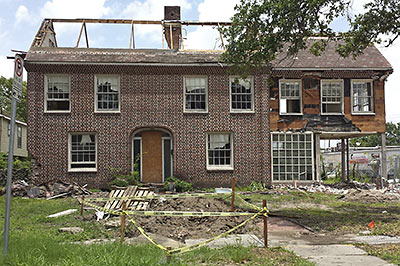
A reader sends a photo of what still remains of this 1930 home at 1813 Arbor St. MLS data show that the 2,004-sq.-ft. house on this 8,000-sq.-ft. Museum Park lot was sold in May for $285,000. Reports the reader: “I thought that they were going to rehab this house but now it looks like they are dismantling it and salvaging bricks and materials.” You can find these ruins a block west of Almeda, directly across the street from those Intexure homes that were reviewed here when featured on the Art Institute of Houston’s 2011 Modern Home Tour.
- 1813 Arbor St. 77004 [NuHabitat]
- A Modern Houston Home [Intexure Architects]
- Previously on Swamplot: Looking in on the Mods
Photo: Swamplot inbox
COMMENT OF THE DAY: WHAT YOU CAN DO WITH AN OLD GROCERY STORE  “The Skaggs Albertson at Louetta and Kuykendahl is now a DPS Drivers License Center. The old Klein’s grocery store in Tomball is being turned into a Veterans Health Center. The old Walmart on 249 just south of Spring Cypress was turned into a training center for a company. The old Randalls on Jones is now a Habitat ReStore.
Another good use is for a fitness center.” [Tejas, commenting on Comment of the Day: All Emptied Out with Nothing To Do] Illustration: Lulu
“The Skaggs Albertson at Louetta and Kuykendahl is now a DPS Drivers License Center. The old Klein’s grocery store in Tomball is being turned into a Veterans Health Center. The old Walmart on 249 just south of Spring Cypress was turned into a training center for a company. The old Randalls on Jones is now a Habitat ReStore.
Another good use is for a fitness center.” [Tejas, commenting on Comment of the Day: All Emptied Out with Nothing To Do] Illustration: Lulu
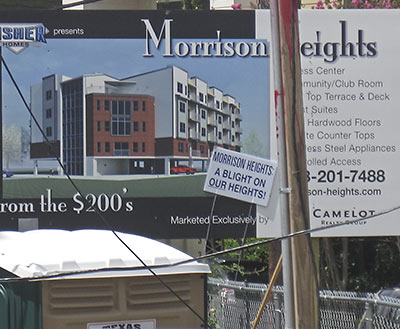
 Across town from the new “Stop the San Felipe Skyscraper” signs popping up in River Oaks and Vermont Commons to oppose the proposed 17-story Hines office building, another crop of anti-development placards is objecting in free verse to the Morrison Heights complex of apartments and condos that’s currently under construction near Houston Ave. and White Oak. Eschewing both the bold imperative of the San Felipe signage and the cartoon menace of the Ashby Highrise hatred, these seem to prefer the rhetorical oomph of puns and wordplay and rhyme. And what, exactly, is the development that has received this poetic ire?
Across town from the new “Stop the San Felipe Skyscraper” signs popping up in River Oaks and Vermont Commons to oppose the proposed 17-story Hines office building, another crop of anti-development placards is objecting in free verse to the Morrison Heights complex of apartments and condos that’s currently under construction near Houston Ave. and White Oak. Eschewing both the bold imperative of the San Felipe signage and the cartoon menace of the Ashby Highrise hatred, these seem to prefer the rhetorical oomph of puns and wordplay and rhyme. And what, exactly, is the development that has received this poetic ire?

